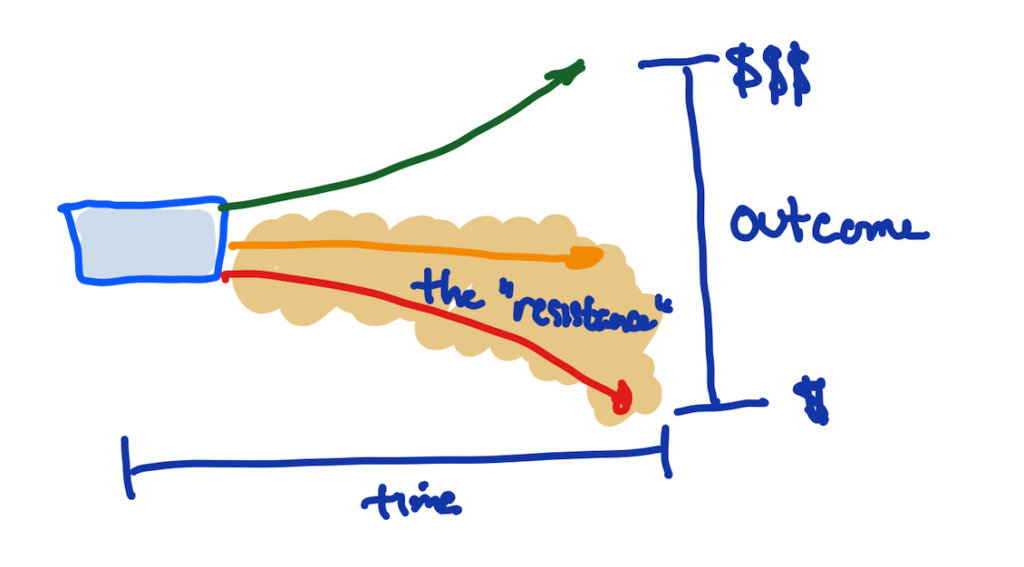
It was a great offsite session.
The core business was profitable, but growth prospects had dimmed. In corporate life, if you don’t hit your year-over-year growth numbers, the team’s momentum and compensation package is significantly reduced. With that in mind, we had worked hard on which of the four growth plays we had researched would be moved to the front of the line.
Everyone was in agreement, and we were ready to charter the new effort. Having been a veteran of many of these kinds of journeys, I was equally excited for the next phase and concerned that we wouldn’t be able to get it done.
The reason? I knew that the real competition had nothing to do with the market.
The Assets That Drive The Opportunity for Acceleration
Once decided upon, transformational projects need to move with dispatch. Those returns promised in the business case need to move from projected to actual in dramatic and swift fashion.
Why? In most firms, far greater than any implicit project risk, is the risk of the core business needs eroding the resources needed for the breakthrough move.
There are two key assets in firms that drive the need for acceleration: budget and talent.
Talent is typically apportioned in the legacy business model by activity drivers. Resources are scaled by need to serve the clients’ existing business architecture. Budget flows accordingly, with a corresponding control and accounting structure.
There is an unspoken responsibility of project sponsors to not only charter the growth effort but seed it with talent. They also, and I would argue most importantly, need to work with their staff and perhaps peers to be sure that the case for investment is well understood, and that we need these results so we ALL do better when it comes to reward.
In other words, the sponsor becomes the one who keeps the balance, assuring that the breakout project doesn’t lose its momentum.
Once a project is formed, transformation leaders spend a significant amount of time negotiating with the core team for access, and once gained, are under constant demand to “return their team.”
The main business has every right to expect access to its resources, and every significant project is seen as “borrowing” them to complete something new with only “abstract” savings or revenue to promise.
In my consulting work, we make sure that there is an airtight business case. We use this clarity with the core team and the divisional talent at large to help the new project move through the firm with as little friction as possible.
History has shown that speed of execution drives down risk and removes the potential for lost talent and cost overruns.
In fact, acceleration is essential and consistently more productive than a measured pace.
Why?
- Our ability to forecast problems to work on in advance is limited. Those things we are used to spending time and money on probably are not the hardest things about our new product, service or process. When working with a team on an industrial project that was slated for outdoor installation, the team hadn’t done the field work to properly kit out a device that could be installed in an active traffic area without tools. The only way to find this kind of “gotcha” is to get into the field with a friendly customer fast.
- We have a calibration problem. Our decision criteria and payback calculations are heavily influenced by the current business and our read on the market. By definition, a transformational improvement will alter the economics. A good example of this involves the completely different economics involved with alternate energy products, e.g. fossil versus solar. Getting tools in place to inform and expedite the decision process pivots on great data – and this data will only come from accurate simulation or in the field work.
- There are always unseen interactions. As we build new products and services, there is always an unanticipated issue that can only be seen in hindsight. In one example I worked on, the product team moved the job of detailed configuration to the field via a tech-based expert system, expecting the channel to be able to make better decisions closer to the application. The truth was that they were unequipped for both the difficulty and specificity of getting it right, costing the firm millions of dollars of field training. The way to get in front of these issues is to bring the project to friendy partners early, or perhaps bring the channel team in on blocking out the initial product architecture.
So, Then How do We do it?
To truly unpack the details is a consulting effort in itself, but here are some ideas to get you started.
- Remove dithering. Set a firm clock on decision making. If it takes more than a day of research it needs to be brought to the leadership team and acted on right away.
- Build the least complex version of a proof of product or service. What portions of the product or service can you build on existing products? What’s the least amount of effort you can consume to better understand the new product or service?
- Find an objective, friendly partner that’s not part of your firm to steer you out of chasing shiny objects. A great example here is after sale service partners – they can save you a fortune in warranty and customer satisfaction.
Wrapping Up
Acceleration is one of nine key accelerators we use to help firms evolve at the pace of their markets. If you’d like to talk further about how to make acceleration work for you and your team, contact us via email or put an appointment on the book by using this link.

